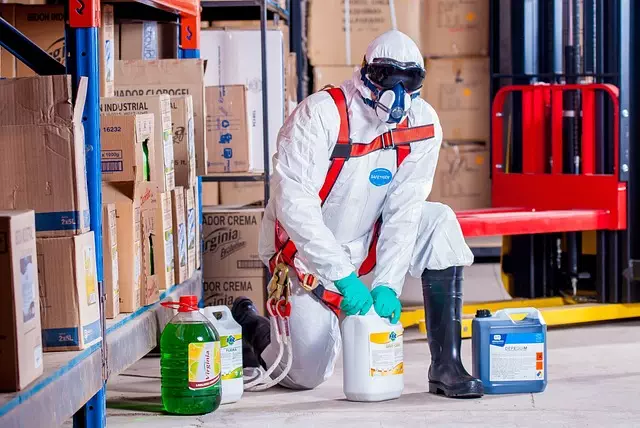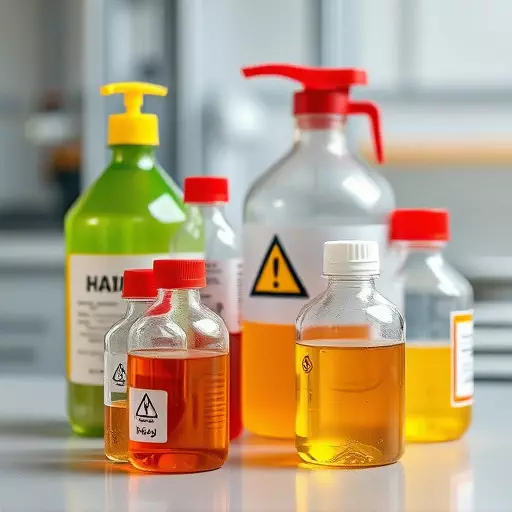Effective chemical exposure risk management in industrial settings hinges on comprehensive knowledge and strict adherence to industrial hygiene protocols. This involves identifying and classifying hazardous materials, implementing control measures like ventilation and PPE, conducting regular audits and monitoring, and providing behavioral safety training that includes proficiency in hazardous material identification. By integrating these practices, organizations can foster a culture of safety, reduce incidents, and ensure the well-being of employees working with chemicals.
In the dynamic landscape of industrial safety, managing chemical exposure risks is paramount. This article explores comprehensive strategies for behavioral safety in chemical environments, focusing on key areas such as identifying hazardous materials, implementing robust industrial hygiene protocols, and providing essential behavioral safety training. We delve into continuous risk management, emphasizing monitoring and improving safety measures to foster a culture of proactive safety. By understanding and mitigating chemical exposure risks, organizations can ensure safer workspaces and enhance overall operational resilience.
- Understanding Chemical Exposure Risks: Identifying Hazardous Materials
- Implementing Industrial Hygiene Protocols for Safe Workspaces
- Essential Components of Behavioral Safety Training in Chemical Environments
- Continuous Risk Management: Monitoring and Improving Safety Measures
Understanding Chemical Exposure Risks: Identifying Hazardous Materials
Understanding Chemical Exposure Risks begins with identifying hazardous materials within a chemical environment. Industrial hygiene protocols demand a comprehensive knowledge of substances present, their potential dangers, and appropriate safety measures. Effective risk management requires workers to be trained in recognizing labels, understanding material safety data sheets (MSDS), and knowing the specific hazards associated with each chemical. This includes physical properties like toxicity, flammability, and reactivity, as well as health effects such as skin irritation, respiratory damage, or long-term exposure consequences.
Identifying hazardous materials is a critical first step in mitigating risks. It involves regular audits, proper storage practices, and clear labeling of containers. By adhering to industrial hygiene protocols, chemical facilities can ensure that employees are aware of potential dangers, equipped with personal protective equipment (PPE), and trained in safe handling procedures. This proactive approach not only protects workers but also contributes to the overall safety and efficiency of the operation.
Implementing Industrial Hygiene Protocols for Safe Workspaces
Implementing Industrial Hygiene Protocols for Safe Workspaces is a critical component in managing chemical exposure risk. These protocols serve as a comprehensive framework aimed at identifying, evaluating, and controlling potential hazards associated with hazardous materials. By integrating industrial hygiene practices, organizations can ensure that employees are protected from harmful substances, fostering a safer work environment.
The process begins with thorough hazardous material identification, where all chemicals present in the workspace are meticulously listed and classified based on their risks. Subsequently, proper control measures are implemented, including engineering controls such as ventilation systems, personal protective equipment (PPE), and safe handling procedures. Regular monitoring and exposure assessments help maintain compliance and identify any emerging issues, allowing for proactive adjustments to safety protocols.
Essential Components of Behavioral Safety Training in Chemical Environments
In chemical environments, where chemical exposure risk management is paramount, behavioral safety training plays a pivotal role in fostering a culture of safety and preventing accidents. This training should encompass several essential components tailored to address the unique challenges of handling hazardous materials. Firstly, employees must be proficient in industrial hygiene protocols, understanding how to monitor and control environmental factors that could lead to chemical exposure.
Secondly, workers should receive comprehensive education on hazardous material identification. This includes learning to recognize various chemicals, their properties, and associated risks. By integrating these elements into safety training programs, organizations can empower employees to make informed decisions, adhere to safety protocols, and proactively manage potential chemical exposure risk management scenarios effectively.
Continuous Risk Management: Monitoring and Improving Safety Measures
In the realm of chemical environments, continuous risk management is paramount to ensuring behavioral safety. Effective monitoring involves regular assessments and audits of industrial hygiene protocols, focusing on identifying and mitigating potential hazards. By implementing robust hazardous material identification processes, organizations can proactively address risks associated with chemical exposure. This proactive approach includes conducting thorough inspections, maintaining up-to-date databases of stored materials, and training employees on the proper handling procedures.
Regular reviews of safety measures help maintain a dynamic environment where improvements are continually sought. It encourages a culture of awareness where employees actively participate in identifying areas for enhancement. Through continuous risk management, chemical facilities can foster a safer working condition, reduce incidents, and promote a holistic approach to behavioral safety, ensuring the well-being of every individual on site.


